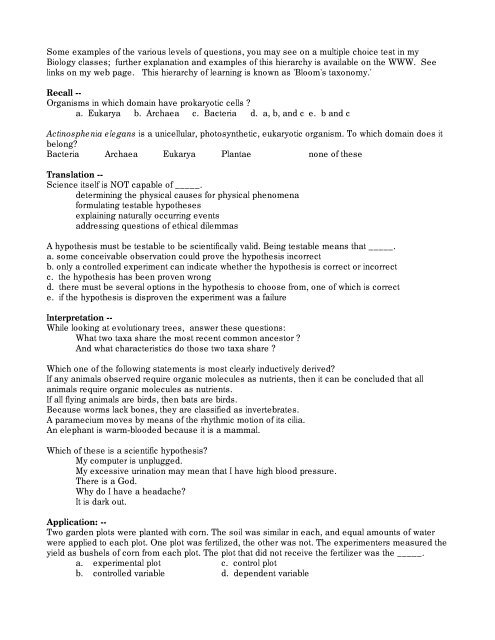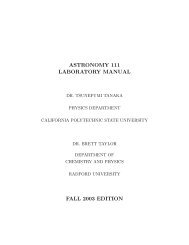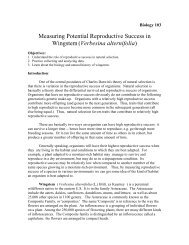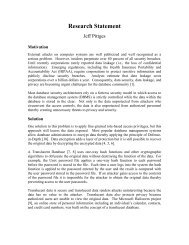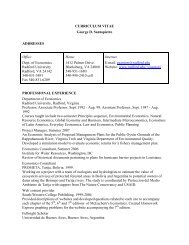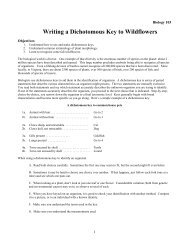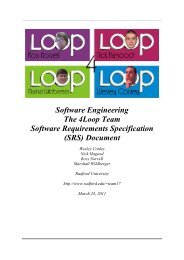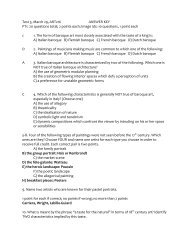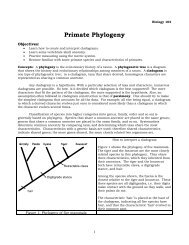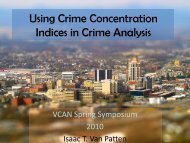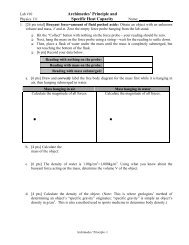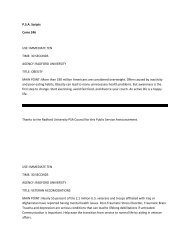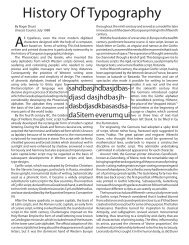Sample questions in Bloom's taxonomy
Sample questions in Bloom's taxonomy
Sample questions in Bloom's taxonomy
You also want an ePaper? Increase the reach of your titles
YUMPU automatically turns print PDFs into web optimized ePapers that Google loves.
Some examples of the various levels of <strong>questions</strong>, you may see on a multiple choice test <strong>in</strong> my<br />
Biology classes; further explanation and examples of this hierarchy is available on the WWW. See<br />
l<strong>in</strong>ks on my web page. This hierarchy of learn<strong>in</strong>g is known as '<strong>Bloom's</strong> <strong>taxonomy</strong>.'<br />
Recall --<br />
Organisms <strong>in</strong> which doma<strong>in</strong> have prokaryotic cells ?<br />
a. Eukarya b. Archaea c. Bacteria d. a, b, and c e. b and c<br />
Act<strong>in</strong>osphenia elegans is a unicellular, photosynthetic, eukaryotic organism. To which doma<strong>in</strong> does it<br />
belong?<br />
Bacteria Archaea Eukarya Plantae none of these<br />
Translation --<br />
Science itself is NOT capable of _____.<br />
determ<strong>in</strong><strong>in</strong>g the physical causes for physical phenomena<br />
formulat<strong>in</strong>g testable hypotheses<br />
expla<strong>in</strong><strong>in</strong>g naturally occurr<strong>in</strong>g events<br />
address<strong>in</strong>g <strong>questions</strong> of ethical dilemmas<br />
A hypothesis must be testable to be scientifically valid. Be<strong>in</strong>g testable means that _____.<br />
a. some conceivable observation could prove the hypothesis <strong>in</strong>correct<br />
b. only a controlled experiment can <strong>in</strong>dicate whether the hypothesis is correct or <strong>in</strong>correct<br />
c. the hypothesis has been proven wrong<br />
d. there must be several options <strong>in</strong> the hypothesis to choose from, one of which is correct<br />
e. if the hypothesis is disproven the experiment was a failure<br />
Interpretation --<br />
While look<strong>in</strong>g at evolutionary trees, answer these <strong>questions</strong>:<br />
What two taxa share the most recent common ancestor ?<br />
And what characteristics do those two taxa share ?<br />
Which one of the follow<strong>in</strong>g statements is most clearly <strong>in</strong>ductively derived?<br />
If any animals observed require organic molecules as nutrients, then it can be concluded that all<br />
animals require organic molecules as nutrients.<br />
If all fly<strong>in</strong>g animals are birds, then bats are birds.<br />
Because worms lack bones, they are classified as <strong>in</strong>vertebrates.<br />
A paramecium moves by means of the rhythmic motion of its cilia.<br />
An elephant is warm-blooded because it is a mammal.<br />
Which of these is a scientific hypothesis?<br />
My computer is unplugged.<br />
My excessive ur<strong>in</strong>ation may mean that I have high blood pressure.<br />
There is a God.<br />
Why do I have a headache?<br />
It is dark out.<br />
Application: --<br />
Two garden plots were planted with corn. The soil was similar <strong>in</strong> each, and equal amounts of water<br />
were applied to each plot. One plot was fertilized, the other was not. The experimenters measured the<br />
yield as bushels of corn from each plot. The plot that did not receive the fertilizer was the _____.<br />
a. experimental plot c. control plot<br />
b. controlled variable d. dependent variable
The best method for determ<strong>in</strong><strong>in</strong>g whether bean plants require sodium is to _____.<br />
measure the amount of sodium <strong>in</strong> a few bean plants<br />
measure how fast radioactive sodium enters the plant<br />
look for sodium <strong>in</strong> leaf tissues us<strong>in</strong>g autoradiography<br />
analyze root contents for sodium<br />
grow bean plants with and without sodium<br />
Analysis:<br />
Should an experiment test only one variable at a time? Why or why not?<br />
Yes, because otherwise the variables could be confused with the control.<br />
Yes, so that the experimental outcome is clearly due to one identifiable variable.<br />
No, because it takes much longer to do an experiment if you change only one variable at a time.<br />
As long as the experiment is repeated a sufficient number of times, it doesn't matter.<br />
None of the above.<br />
Look<strong>in</strong>g at results of an experiment, and determ<strong>in</strong><strong>in</strong>g what statistiical test to use, how to graph them,<br />
and what the results mean, requires analytical skills.<br />
Synthesis<br />
A pesticide kills 99.9% of a pest population. What will be the result of the cont<strong>in</strong>ued application of this<br />
pesticide?<br />
Every time the pesticide is applied, it will kill 99.9% of the pest population.<br />
Eventually, all of the pest population will be wiped out.<br />
The pest population will reach an equilibrium po<strong>in</strong>t at which the pesticide is 50% effective.<br />
Through time, the pesticide will become less effective at kill<strong>in</strong>g the pest.<br />
The pesticide will become resistant to the pest.<br />
Evaluation, e.g. Evaluat<strong>in</strong>g the results of an experiment.<br />
Apply<strong>in</strong>g values, e.g. should embryonic stem cells be used <strong>in</strong> research ?<br />
Apply<strong>in</strong>g values, e.g., What should the sewage treatment plant do with the sludge they produce ?


